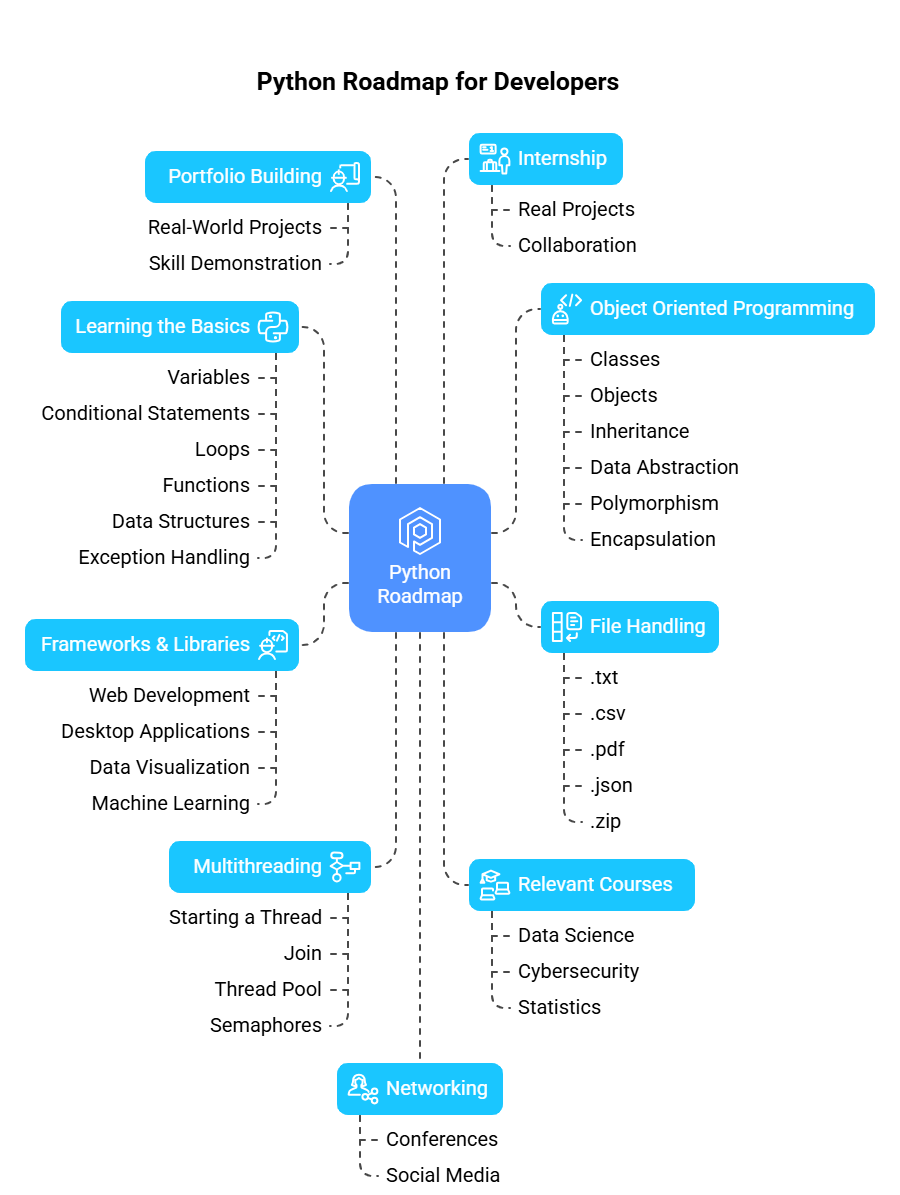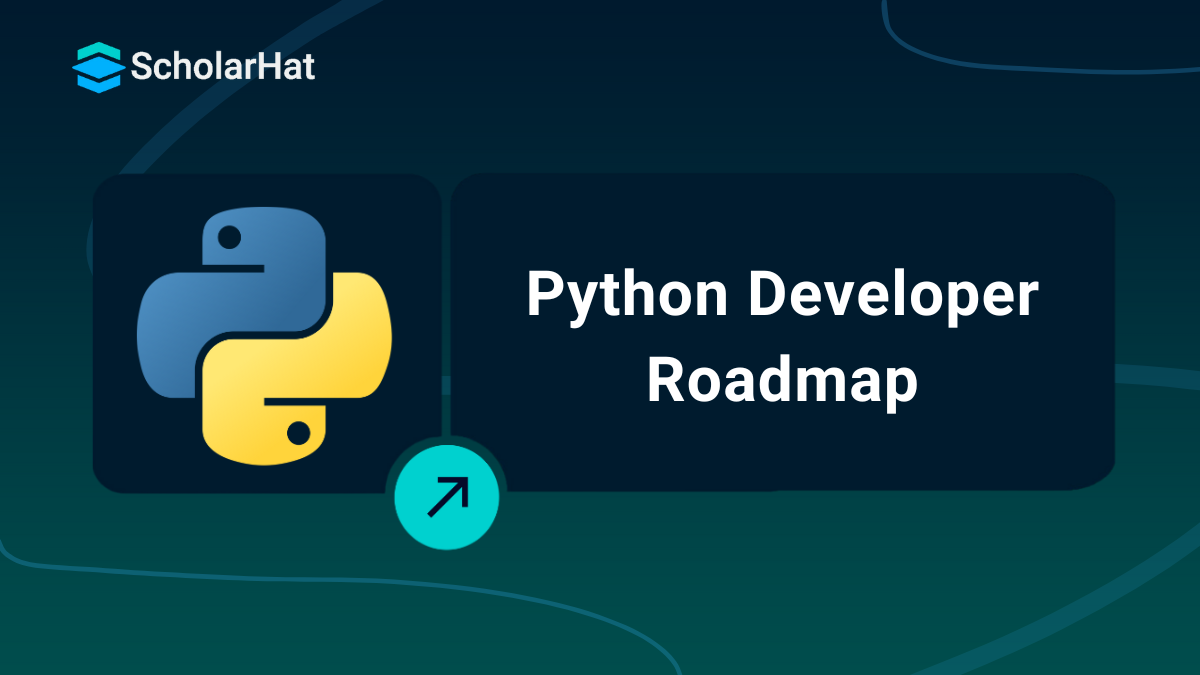26
DecPython Roadmap: How to become a Python Developer?
A Python roadmap is a visual and strategic document that outlines a path to becoming proficient in Python. Whether your goal is to be a data scientist or a full-stack developer using Python, this guide will help you every step of the way. It starts with the basics of syntax and gradually guides you to advanced Python programming.
In this Python tutorial, we will look into the details of the step-by-step procedure on how to become a Python developer. Python developer earn 50% more than average coders. Enroll in our Free Python Developer Course now and unlock ₹20 LPA jobs!
Who is a Python Developer & What Do They Do?
A Python developer is a software engineer or programmer with expertise in creating, managing, and refining applications using the Python programming language. Python is a well-liked general-purpose, high-level programming language that is easy to learn and use. It is extensively utilized in many domains, including automation, scripting, artificial intelligence, machine learning, data science, and web development.
Different Roles as a Python Developer:
- Web Developer
- Data Analyst / Data Scientist
- AI/ML Engineer
- Automation Scripter
- Game Developer
Complete Roadmap to Learn Python
This Python roadmap covers the core abilities that any Python developer should be familiar with, such as Python syntax and data structures, essential Python frameworks, the importance of data science, and machine learning skills, which are in high demand in almost all industries today. Let's delve into it.

1. Learning the Basics of Python
Before starting learning Python, you first have to download the latest version of Python from Python’s official website and then install it on your operating system.Once the installation is done, you can write and run Python code with an IDE.
In this section, we learn foundational topics to strengthen your fundamentals. The following topics will be covered under this:
- Variables in Python and String Manipulation
- Conditional statements in Python
- Loops in Python
- Functions in Python, modules & Imports
- Data structures like Lists in Python and Dictionaries in Python
- Exception handling in Python
2. Python Object Oriented Programming (OOP)
The following topics you need to study here:
- Classes
- Object
- Inheritance
- Data Abstraction
- Polymorphism
- Encapsulation
Read More - Python Developer Salary in India
3. Frameworks & Libraries
Frameworks are collections of core software modules that comprise pre-written code that programmers may utilize to address typical programming tasks. Using frameworks, developers may build project-specific functionality without starting from scratch. Frameworks reduce the amount of code that one has to write. Thus making programming more efficient. Understanding these frameworks and libraries is critical to speed development and creating efficient and scalable applications.
- Web Development: Let us learn about the various Python libraries used for web applications.
1. Django
It is a high-level Python web framework helpful for quickly and efficiently constructing web applications. It follows the Model-View-Controller (MVC) architectural pattern, making it simple to create sophisticated web applications with a well-defined structure. You must know its built-in admin interface and powerful object-relational mapper for developing scalable, maintainable online applications that are simple to install and manage.
2. Flask
It is a micro web framework to build a simple website. It is much easier to learn than Django. Flask provides a wide range of extensions, which can be used to add features such as authentication, database integration, and more. Flask is also known for its flexibility, allowing developers to create applications in various ways.
3. FastAPI
It is a high-performance Python web framework for quickly and efficiently constructing APIs. It is intended to be simple to use and quick to develop, making it a popular choice for developers looking to build robust APIs. FastAPI is a significant addition to any Python developer's toolkit due to its current features and emphasis on performance.
- Desktop Applications: Now let us look at the various Python libraries used to create desktop applications.
1. Tkinter
It is a GUI (Graphical User Interface) toolkit included with Python. Tkinter is an open-source library and it allows you to build desktop GUI applications using Python. To create interactive and user-friendly desktop programs, Python developers must thoroughly understand Tkinter. To develop interactive interfaces, Tkinter provides a variety of widgets such as buttons, labels, menus, and many more.
2. PyQT
PyQt is a Python binding of the well-known cross-platform Qt framework, which is used to create graphical user interfaces (GUIs) for desktop and mobile applications. PyQt has several tools and features for developing powerful graphical user interfaces, such as drag and drop, keyboard shortcuts, menus, and dialogues.
- Data Visualization: It's time to have a look at various Data Visualization libraries offered by Python.
1. Matplotlib
Matplotlib offers a wide range of plotting capabilities and assists developers in creating high-quality data representations. Knowing Matplotlib is essential for Python data analysis and visualization activities. It is widely used to create bar charts, line plots, histograms, and other graphs. Matplotlib is a powerful tool in any Python developer's tool set due to its user-friendly syntax and various features.
2. Seaborn
Seaborn is based on Matplotlib and offers a higher-level interface for creating beautiful and useful visualizations with less code. In addition, the library supports various visualization types, such as heatmaps, scatterplots, and line plots, and includes features such as color palettes and statistical analysis tools. As a result, Seaborn is extremely effective for studying and displaying large amounts of data.
- Machine Learning
1. TensorFlow
It is the most popular deep learning library developed by Google. It is a computational framework that expresses algorithms that involve numerous Tensor operations.
2. Scikit-Learn
A machine learning library for Python, designed to work with numerical libraries such as SciPy & NumPy.
3. PyTorch
It can handle dynamic computation graphs on the go. It also provides an easy-to-use API.
4. Python Multithreading
The following topics you need to learn here:
- Starting a thread
- Join
- Thread pool
- Semaphores
5. File Handling in Python
Python is the best programming language to edit, script, and automate whatever is related to the below file formats.
- .txt
- .csv
- .json
- .zip
6. Take relevant courses
Some courses you might take are data science fundamentals with Python, Python for cybersecurity, and statistics with Python. You will get good exposure to various problem-solving techniques in such courses.
We, at ScholarHat, also offer the following course to help you improve your Python development skills:
7. Build a Nice Portfolio with Projects
As a Python developer, building a strong portfolio with projects is crucial for demonstrating your skills and experience to potential employers or clients. Focus on creating high-quality projects that solve real-world problems and demonstrate your expertise.
8. Take an Internship
Internships are an amazing opportunity to gain real-world experience, learn new skills, and network with industry professionals. Through internships, you get to work on real projects and collaborate with experienced developers, explore different industries and technologies, gain valuable experience, expand your network, and increase your chances of success as a Python developer.
15. Develop a Good Network
Developing a good network is crucial for finding job opportunities and advancing your career. Networking involves building professional relationships with people in your industry, such as colleagues, mentors, recruiters, and alumni. Networking can be done both in-person and online through social media platforms such as LinkedIn.
By attending Python conferences, you can learn different ideas and techniques for coding and observe new programming products. Various experts share their ideas at these conferences. You can have productive discussions with other Python developers and get advice about how to enhance your work.
Read More:
Summary
In the above article, we explored in quite detail the complete roadmap for becoming a Python developer to build their career in the AI-driven world.
90% of tech giants prefer full-stack talent. Enroll in our Full-Stack Python Course or risk missing out!
| Download this PDF Now - Python Developer Roadmap PDF By Scholarhat |
FAQs
- Starting a thread
- Join
- Thread pool
- Semaphores
- Variables in Python and String Manipulation
- Conditional statements in Python
- Loops in Python
- Functions in Python, modules & Imports
Take our Python skill challenge to evaluate yourself!

In less than 5 minutes, with our skill challenge, you can identify your knowledge gaps and strengths in a given skill.






